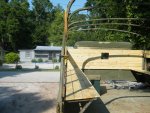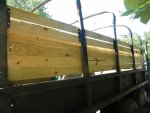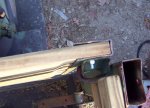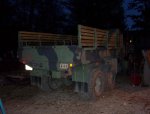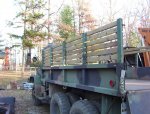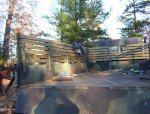Leaving aside the "That Aint oak" and other posts for a moment, the original question was "What kind of wood..."
The seats I've seen and worked on are mostly hickory. We one time referred to the MILSPEC to have slats locally fabricated and it was mind numbing. It read something like "Material to be of 90 % clear hickory (grade as specified by the Forest Products Board and graded from the poor face) with essentially vertical grain orientation (no more than 30 degrees pitch from vertical) as referenced from the long face. Exhibited annular growth rings to be no more than 17 per lineal inch and no less than 10 per lineal inch as referenced perpendicular to the predominate grain orientation. Yadda, Yadda, Yadda......"
Holy smokes! All we wanted was a plank that wouldn't leave a splinter in Joe's butt!
Getting paint to adhere has always been a problem. Automotive paints have never had the elasticity to long survive the humidity driven dimensional movement of wood.
Fiberglass slats look good but won't tolerate shock loads like tossing firewood into the bed as well as wood. Also, if you get a wood splinter in your butt, you can rely on "buddy aid" to get it out. If you get a fiberglass splinter in your butt you are going to an emergency room or urgent care center.
Modern pressure treated woods (ACQ) are galvanicly corrosive with most metals. Keep an eye on them.
BTW as a cabinet maker and finish and trim carpenter, I'll say, "That aint oak" too. Looking at the growth rings, the spike knots coming from both edges etc. I'd also guess it is SYP (southern yellow pine) or SPF (spruce, pine, fir) of No. 2 common grade. In either case they came from trees about as big around as my thigh and the show none of the sap wood or wain that small diameter oak would exhibit.
Lance




